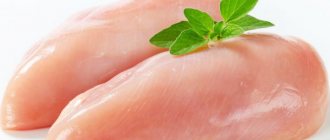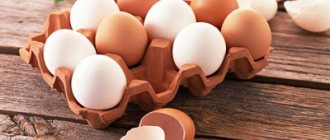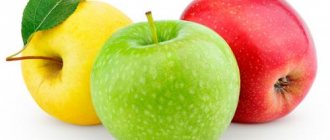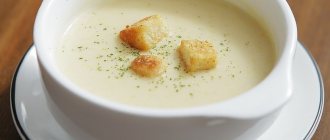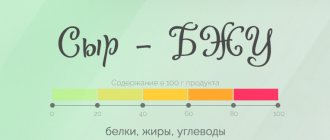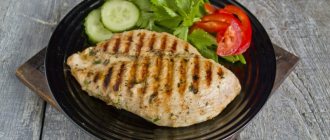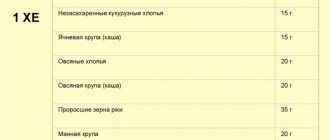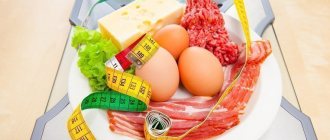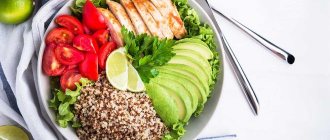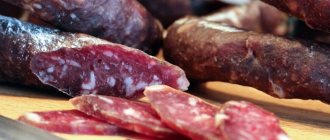Types and composition
The main types of sausages include:
- boiled (including sausages and sausages);
- smoked;
- boiled-smoked;
- semi-smoked;
- raw smoked;
- dry-cured;
- liver (as well as brawn).
The classic composition includes minced meat and natural spices.
Manufacturers use one or more of the following types of meat to prepare various sausage products:
- beef;
- pork;
- poultry meat;
- lard;
- lamb;
- horse meat
This product does not last long. Doctors consider sausages made exclusively from minced meat with spices to be a healthy diet. Indeed, sausage made from natural ingredients is healthy. But it is very difficult to find such a useful product on the counter, and besides, it can have a rather high price.
Affordable types and brands of sausages, for the most part, contain various additives in addition to the main ingredients. It is not recommended to regularly consume such products.
Sausages are not included in the diet menu. Despite the complete absence of carbohydrates (or no more than 3% per 100 grams in some varieties), sausage contains a large amount of fat, which increases its calorie content.
In addition to fats, sausages are high in protein. Therefore, in many so-called protein diets, the consumption of a certain amount of sausages is allowed.
Sausage comments
- It's disgusting if the sausage is bought in a store! You can get poisoned... But many people buy it because they are used to living like this. I definitely won’t feed my children these products.
- When I read about blood sausage, I almost felt sick. I don't know how to eat it at all. And who came up with it, why did they come up with it? There are many other alternatives you can eat. And why make the sausage yourself if everything is for sale?
- Orthodox believers should not eat any sausage! These are animals! We eat a lot of things that we shouldn't. But people don't understand. Many people don't understand, unfortunately. And I can't control the whole world. And I wouldn’t want to, because it’s a responsibility.
- I'm always on a diet. I don't eat sausage. And I don’t eat sausages and don’t crave them! And what? I wouldn't die without them! Even without a diet, I would eat little, because I have a lot of worries in my personal life.
BZHU sausages
Data are given per 100 grams:
| View | Fats | Squirrels | Carbohydrates |
| Boiled | 11-30 g | 10-18 g | up to 3 g |
| Boiled-smoked | 16-41 g | 12-21 g | up to 2 g |
| Semi-smoked | 16-51 g | 11-20 g | up to 3 g |
| Raw smoked | 38-65 g | 8-25 g | up to 0.5 g |
| Livernaya | 30 g | 15 g | up to 3 g |
Calorie content of Salami. Chemical composition and nutritional value.
Nutritional value and chemical composition of "Salami".
The table shows the nutritional content (calories, proteins, fats, carbohydrates, vitamins and minerals) per 100 grams of edible portion.
| Nutrient | Quantity | Norm** | % of the norm in 100 g | % of the norm in 100 kcal | 100% normal |
| Calorie content | 494 kcal | 1684 kcal | 29.3% | 5.9% | 341 g |
| Squirrels | 20 g | 76 g | 26.3% | 5.3% | 380 g |
| Fats | 46 g | 56 g | 82.1% | 16.6% | 122 g |
| Water | 30.72 g | 2273 g | 1.4% | 0.3% | 7399 g |
| Ash | 5.34 g | ~ | |||
| Vitamins | |||||
| Vitamin B1, thiamine | 0.355 mg | 1.5 mg | 23.7% | 4.8% | 423 g |
| Vitamin B2, riboflavin | 0.316 mg | 1.8 mg | 17.6% | 3.6% | 570 g |
| Vitamin B4, choline | 77.1 mg | 500 mg | 15.4% | 3.1% | 649 g |
| Vitamin B5, pantothenic | 1.183 mg | 5 mg | 23.7% | 4.8% | 423 g |
| Vitamin B6, pyridoxine | 0.353 mg | 2 mg | 17.7% | 3.6% | 567 g |
| Vitamin B9, folates | 5 mcg | 400 mcg | 1.3% | 0.3% | 8000 g |
| Vitamin B12, cobalamin | 1.73 mcg | 3 mcg | 57.7% | 11.7% | 173 g |
| Vitamin C, ascorbic acid | 0.7 mg | 90 mg | 0.8% | 0.2% | 12857 g |
| Vitamin D, calciferol | 0.2 mcg | 10 mcg | 2% | 0.4% | 5000 g |
| Vitamin K, phylloquinone | 5.8 mcg | 120 mcg | 4.8% | 1% | 2069 g |
| Menaquinone-4 (MK4) | 41.7 mcg | ~ | |||
| Vitamin RR, NE | 4.64 mg | 20 mg | 23.2% | 4.7% | 431 g |
| Betaine | 2.8 mg | ~ | |||
| Macronutrients | |||||
| Potassium, K | 279 mg | 2500 mg | 11.2% | 2.3% | 896 g |
| Calcium, Ca | 22 mg | 1000 mg | 2.2% | 0.4% | 4545 g |
| Magnesium, Mg | 21 mg | 400 mg | 5.3% | 1.1% | 1905 |
| Sodium, Na | 1761 mg | 1300 mg | 135.5% | 27.4% | 74 g |
| Phosphorus, Ph | 177 mg | 800 mg | 22.1% | 4.5% | 452 g |
| Microelements | |||||
| Iron, Fe | 1.62 mg | 18 mg | 9% | 1.8% | 1111 g |
| Manganese, Mn | 0.595 mg | 2 mg | 29.8% | 6% | 336 g |
| Copper, Cu | 112 mcg | 1000 mcg | 11.2% | 2.3% | 893 g |
| Selenium, Se | 35 mcg | 55 mcg | 63.6% | 12.9% | 157 g |
| Zinc, Zn | 2.5 mg | 12 mg | 20.8% | 4.2% | 480 g |
| Essential amino acids | |||||
| Arginine* | 1.298 g | ~ | |||
| Valin | 0.987 g | ~ | |||
| Histidine* | 0.688 g | ~ | |||
| Isoleucine | 0.901 g | ~ | |||
| Leucine | 1.575 g | ~ | |||
| Lysine | 1.652 g | ~ | |||
| Methionine | 0.511 g | ~ | |||
| Threonine | 0.869 g | ~ | |||
| Tryptophan | 0.23 g | ~ | |||
| Phenylalanine | 0.778 g | ~ | |||
| Nonessential amino acids | |||||
| Alanin | 1.178 g | ~ | |||
| Aspartic acid | 1.825 g | ~ | |||
| Hydroxyproline | 0.382 g | ~ | |||
| Glycine | 1.073 g | ~ | |||
| Glutamic acid | 3.009 g | ~ | |||
| Proline | 0.862 g | ~ | |||
| Serin | 0.771 g | ~ | |||
| Tyrosine | 0.661 g | ~ | |||
| Cysteine | 0.228 g | ~ | |||
| Sterols (sterols) | |||||
| Cholesterol | 105 mg | max 300 mg | |||
| Phytosterols | 5 mg | ~ | |||
| Fatty acid | |||||
| Trans fats | 1.634 g | max 1.9 g | |||
| monounsaturated trans fats | 1.359 g | ~ | |||
| polyunsaturated trans fats | 0.275 g | ~ | |||
| Saturated fatty acids | |||||
| Saturated fatty acids | 14.9 g | max 18.7 g | |||
| 14:0 Miristinovaya | 0.92 g | ~ | |||
| 15:0 Pentadecane | 0.123 g | ~ | |||
| 16:0 Palmitinaya | 8.736 g | ~ | |||
| 17:0 Margarine | 0.306 g | ~ | |||
| 18:0 Stearic | 4.725 g | ~ | |||
| 20:0 Arakhinovaya | 0.05 g | ~ | |||
| Monounsaturated fatty acids | 17.166 g | min 16.8 g | 102.2% | 20.7% | |
| 14:1 Myristoleic | 0.18 g | ~ | |||
| 16:1 Palmitoleic | 1.008 g | ~ | |||
| 18:1 Oleic (omega-9) | 15.693 g | ~ | |||
| 18:1 cis | 14.335 g | ~ | |||
| 18:1 trans | 1.359 g | ~ | |||
| 20:1 Gadoleic (omega-9) | 0.194 g | ~ | |||
| 22:1 Erucic (omega-9) | 0.091 g | ~ | |||
| 22:1 cis | 0.091 g | ~ | |||
| Polyunsaturated fatty acids | 3.426 g | from 11.2 to 20.6 g | 30.6% | 6.2% | |
| 18:2 Linolevaya | 3.071 g | ~ | |||
| 18:2 Omega-6, cis, cis | 2.796 g | ~ | |||
| 18:2 trance, trance | 0.275 g | ~ | |||
| 18:3 Linolenic | 0.187 g | ~ | |||
| 18:3 Omega-3, alpha-linolenic | 0.187 g | ~ | |||
| 20:2 Eicosadiene, Omega-6, cis, cis | 0.1 g | ~ | |||
| 20:4 Arachidonic | 0.067 g | ~ | |||
| Omega-3 fatty acids | 0.2 g | from 0.9 to 3.7 g | 22.2% | 4.5% | |
| Omega-6 fatty acids | 3 g | from 4.7 to 16.8 g | 63.8% | 12.9% |
The energy value of Salami is 494 kcal.
Primary Source: Created in the application by the user. Read more.
** This table shows the average levels of vitamins and minerals for an adult. If you want to know the norms taking into account your gender, age and other factors, then use the “My Healthy Diet” application.
Composition of nutrients, BJU
Beef sausage – 1 piece (23g)
| For quantity: 1 piece | ||
| Calories — 65 | Calories from fat - 48 | |
| BJU | ||
| Total fat content | 5.38g | |
| Saturated | 1.97g | |
| Polyunsaturated | 0.4g | |
| Monounsaturated | 2.34g | |
| Cholesterol | 15.64 mg | |
| Total carbohydrate content | 0.68g | |
| Dietary fiber | 0.01g | |
| Sugar | 0.09g | |
| Squirrels | 3.34g | |
| Vitamins and microelements | ||
| A - 3.41 µg | C - 0.24 mg | |
| B-6 – 0.04 mg | B-12 - 0.4 µg | |
| D - 0.14 µg | E - 0.05 mg | |
| Calcium 5.52µg | Iron 0.37 mg | |
| Magnesium 3.17 mg | Zinc 0.56mg | |
| Potassium 53.13 mg | Sodium 244.72 mg | |
Distribution of calories for BJU:Carbohydrates (6%) Fats (74%) Proteins (20%) | ||
Calorie content of sausages of different types and brands
All data is given per 100 grams. On average, sausages contain from 165 to 605 kcal.
Calorie content of boiled sausage
The least calorie type. The general figure ranges from 165 to 315 kcal (depending on the variety).
| Name | Calories | Name | Calories |
| Beef | 170 | Moscow | 248 |
| Diabetic | 255 | Separate | 240 |
| Dietary | 165 | Podmoskovnaya (with chicken) | 175 |
| For breakfast | 190 | Russian | 300 |
| Doctoral | 260 | Pork | 280 |
| Zelenogradskaya (with duck meat) | 190 | Stolichnaya | 320 |
| Amateur | 300 | Dining room | 235 |
| Amateur pork | 315 | Veal | 315 |
| Dairy | 250 | Teahouse | 215 |
Calorie content of boiled smoked sausage
The general indicator is from 270 to 460 kcal.
| Name | Calories | Name | Calories |
| Boiled-smoked | 345 | Cervelat | 460 |
| Fried chicken | 270 | Servelat boyarsky | 270 |
| Amateur | 421 | Russian cervelat | 415 |
| Moscow | 405 | Tallinnskaya | 380 |
Calorie content of semi-smoked sausage
Quite a high-calorie type. The general indicator is from 275 to 500 kcal.
| Name | Calories | Name | Calories |
| Armavir | 425 | Odessa | 400 |
| Snack bar | 366 | Poltavskaya | 415 |
| Krakow | 466 | Salami amateur | 500 |
| Amateur | 425 | Cervelat | 420 |
| Minsk | 280 | Tallinnskaya | 375 |
| Moscow | 405 | Ukrainian | 380 |
Calorie content of raw smoked sausage
This type is the leader in terms of calorie content. The general indicator is from 435 to 605 kcal.
| Name | Calories | Name | Calories |
| Brunswick | 490 | Napoli | 320 |
| Road | 500 | Olympic | 435 |
| Grainy | 605 | Pork | 565 |
| Amateur | 515 | Cervelat | 460 |
| Moscow | 475 | Stolichnaya | 490 |
Calorie content of liver sausage
The average value is 325 kcal, but can vary from 195 to 455 kcal.
Calorie content of dry-cured sausage
The average value is 400-450 kcal.
Calories of boiled sausages, ham
| Name of sausage | Calories | Protein | Fat | Carbohydrates |
| boiled milk sausage | 252.0 | 11.7 | 22.8 | 0.0 |
| Boiled sausage Doctorskaya | 257.0 | 12.8 | 22.2 | 1.5 |
| Russian sausage | 302.0 | 11.8 | 28.9 | 0.0 |
| Amateur chicken ham (Ryazan broiler) | 143.0 | 14.9 | 7.1 | 0.0 |
| Egorievo ham | 139.0 | ? | ? | ? |
| chicken breast balyk Cherkizovo | 109.0 | 16.0 | 5.0 | 0.0 |
| ham empire taste from turkey | 90.0 | ? | ? | ? |
| brawn - beef tongue | 212.0 | 22.4 | 13.6 | 2.4 |
| liverwurst - type of sausage | 384.0 | 12.5 | 35.7 | 4.3 |
| saltison is also a sausage | 336.0 | 12.6 | 32.0 | 0.5 |
| ham roll | 143.0 | 14.9 | 9.3 | 0.1 |
How many calories are in different servings:
65
283
2.83
| Qty | A portion | Calories | In the counter |
| 1 piece = 23g | 65 | ||
| 100 g | 283 | ||
| 1 g | 2.83 | ||
| 1284 | 1 lb (16 oz) = 453.6g | 1284 | |
| 80 | 1 ounce = 28.35g | 80 | |
| 139 | 1 serving = 49g | 139 | |
| 215 | 1 serving (2.67 oz) = 76g | 215 | |
| 158 | 2 oz (1 serving) = 56g | 158 | |
| 241 | 3 oz = 85g | 241 | |
| 320 | 7 sausages (4 oz) = 113g | 320 |
Raw smoked sausage Servelat
Cervelat is one of the delicious varieties of smoked dry sausage. Made from beef and pork with the addition of various spices. It has a characteristic smoked-spicy taste and a corresponding pleasant aroma.
Manufacturing
As you know, Switzerland is considered the birthplace of cervelat, where this sausage product has been produced for centuries. The traditional recipe for preparing cervelat involves using a mixture of beef, bacon, cracklings and seasonings. It is filled with bovine intestines with a diameter of about 4 cm and a length of 12 cm. Under the influence of high temperature, the sausage takes on a characteristic round shape, while the skin becomes very dense, with a characteristic crunch on the teeth when consumed.
In the post-Soviet space, cervelat is manufactured mainly according to GOST. According to this standard, this sausage product must contain premium beef (25%), lean (25%) and fatty pork or pork breast (50%). In this case, a mixture of salt, sugar, sodium nitrite, ground black or white pepper, and ground cardamom is used as an enhancer and flavor modifier. Nutmeg was allowed as an alternative to cardamom.
Calorie content
100 grams of cervelat contain about 309 kcal.
Compound
The chemical composition of cervelat is characterized by a high content of proteins, fats, saturated fatty acids, cholesterol, ash, vitamins (B1, B2, B3, E), minerals (iodine, iron, phosphorus, potassium, sodium, magnesium, calcium).
How to cook and serve
Cervelat is used in cooking as a snack, as well as for making various salads, sandwiches, sandwiches. In addition, this sausage product is often used in the preparation of certain types of pizza, as well as a number of stewed, boiled and fried dishes of Swiss cuisine. It is served thinly sliced and peeled along with various baked goods and sauces.
How to choose
The main factor in choosing cervelat is the appearance of this sausage product, namely its casing. Its surface should be dry, dense and elastic, tightly adjacent to the minced meat, without any stains or mold deposits. Also, the quality of cervelat can be determined by the cut. A quality sausage product is distinguished by its uniform color, dense elastic consistency, and the absence of gray spots.
Storage
The optimal conditions for storing cervelat are temperatures from 0 to +4 degrees Celsius and air humidity from 75 to 80%. In this case, and in the absence of damage to the casing, this sausage product will retain all its original organoleptic qualities for 30 days.
Cut cervelat should also be stored in the refrigerator, but first place it in a tightly closed container made of glass or plastic. In this form, the sausage product must be consumed within a week.
Beneficial features
Like other sausages, cervelat will have a beneficial effect on the human body only when consumed in limited quantities. In this case, you can count on stimulating the processes of metabolism, hematopoiesis, the formation of bone and muscle tissue, cholesterol metabolism and hormonal activity. In addition, cervelat accelerates recovery after significant physical exertion.
Is it possible to eat sausage while on a diet?
From the point of view of a healthy diet, doctors advise excluding sausage delicacies from the diet not only for those who are on a diet, but in general for everyone, because the majority of the product is not meat at all, but emulsion, soy, etc. Sausage for a diet should contain exclusively meat, lard, salt, spices and sodium nitrite.
Interesting materials:
Is it possible to provide data from government services? Is it possible to give a kitten raw turkey? Is it possible to give a dog human medications? Is it possible to give cheese to a guinea pig? Is it possible to do nikah with a Christian? Is it possible to have nose surgery at 15? Is it possible to make holes in a suspended ceiling? Can wood be washed in the dishwasher? Is it possible to keep a freezer in an unheated room? Is it possible to keep a poinsettia flower in an apartment?
